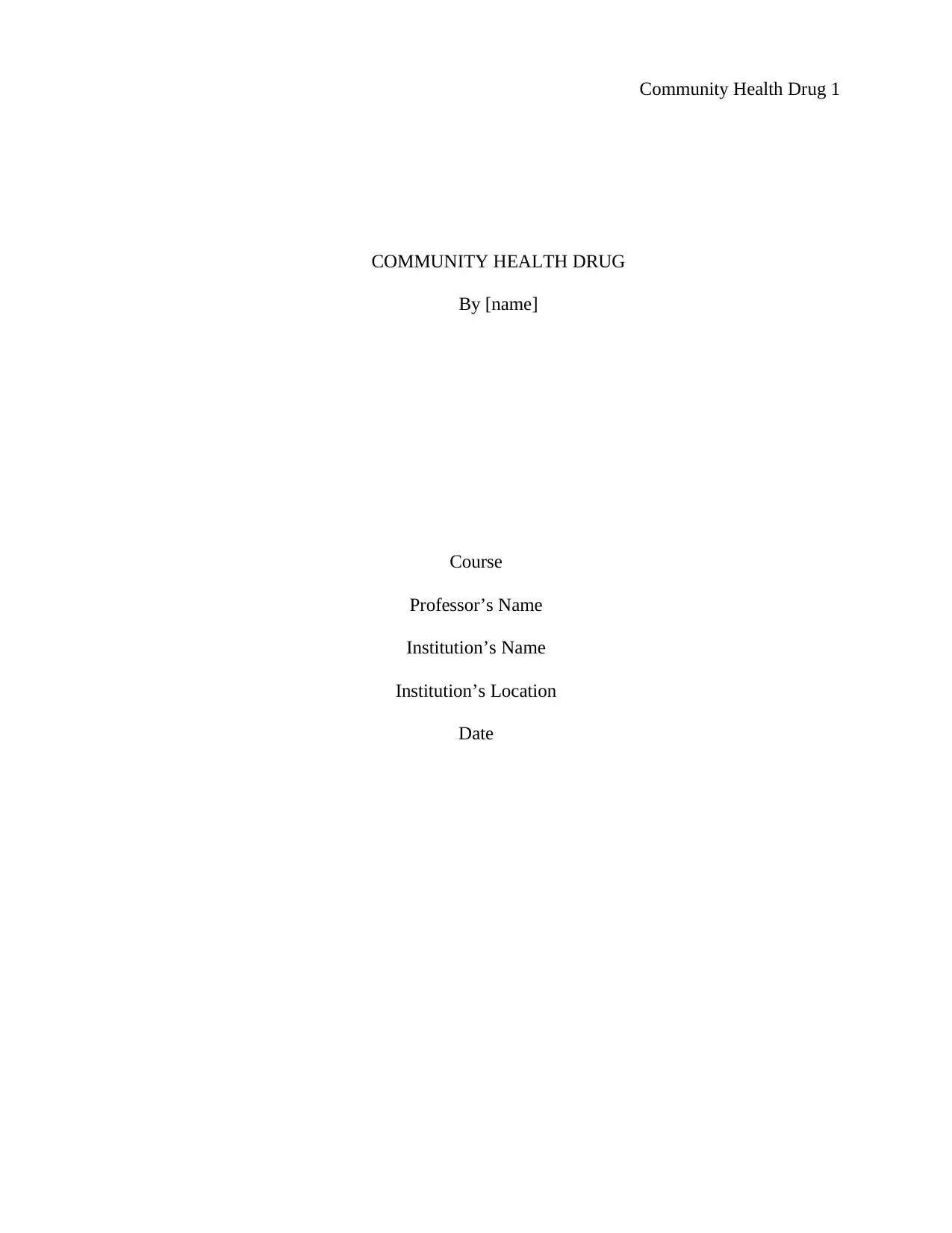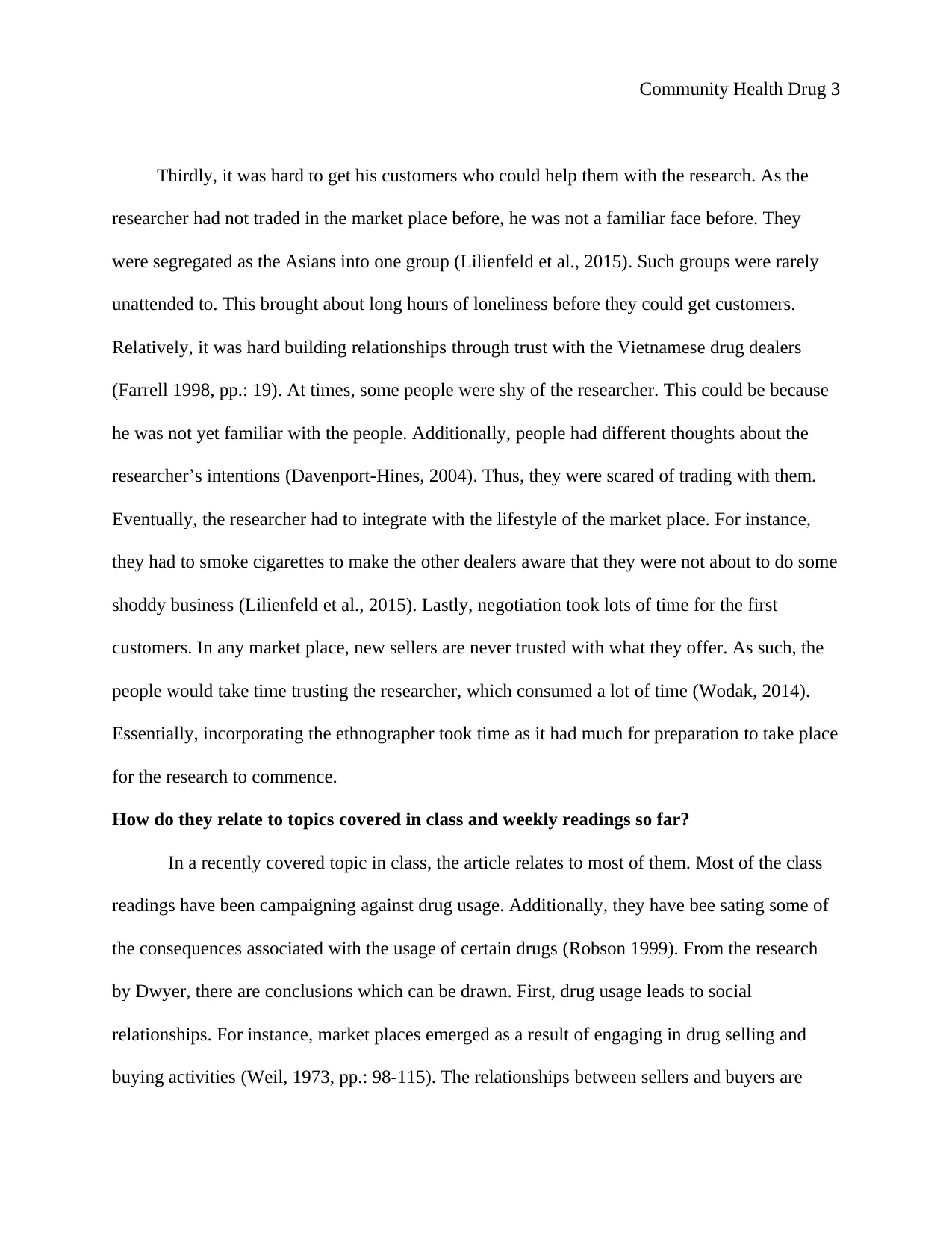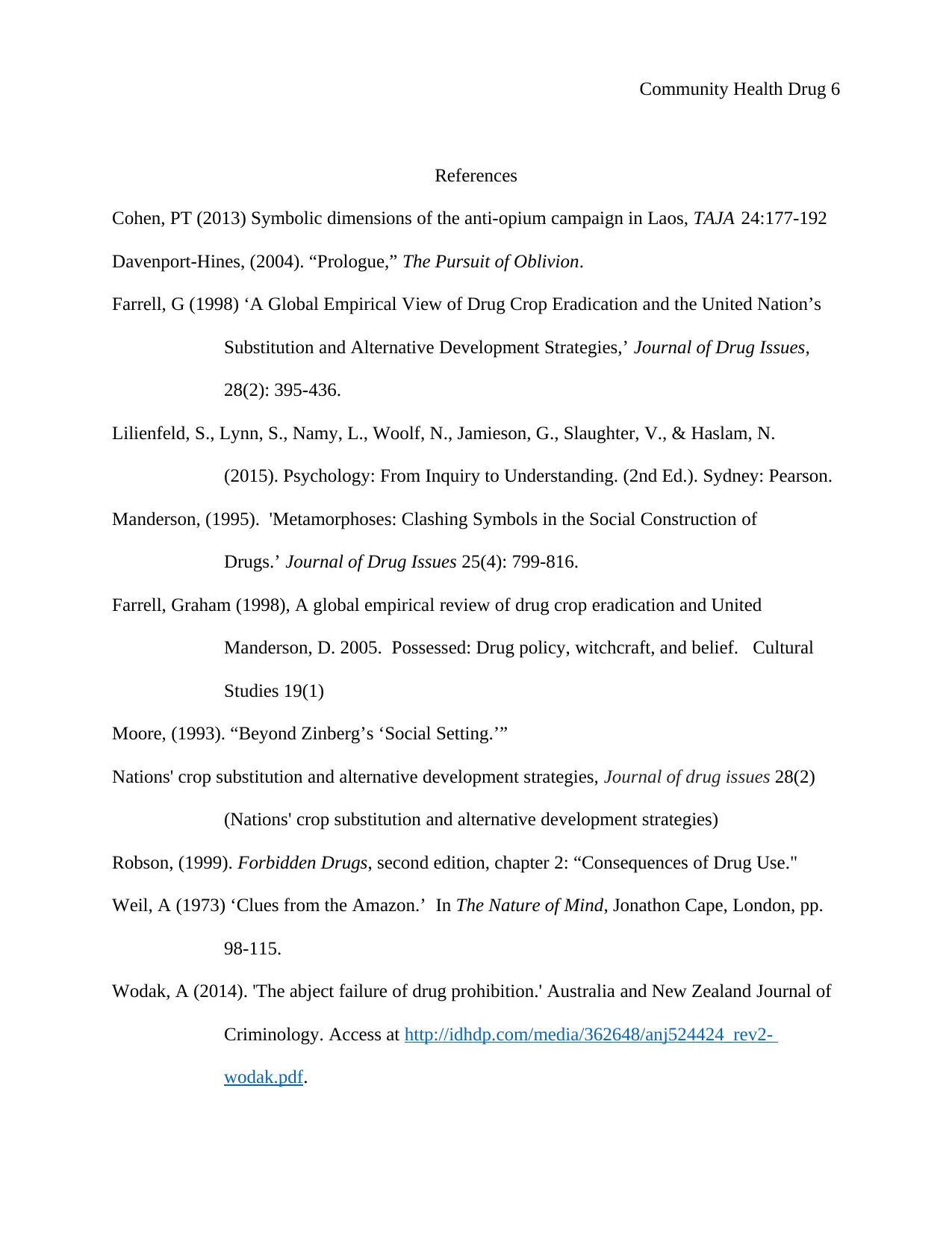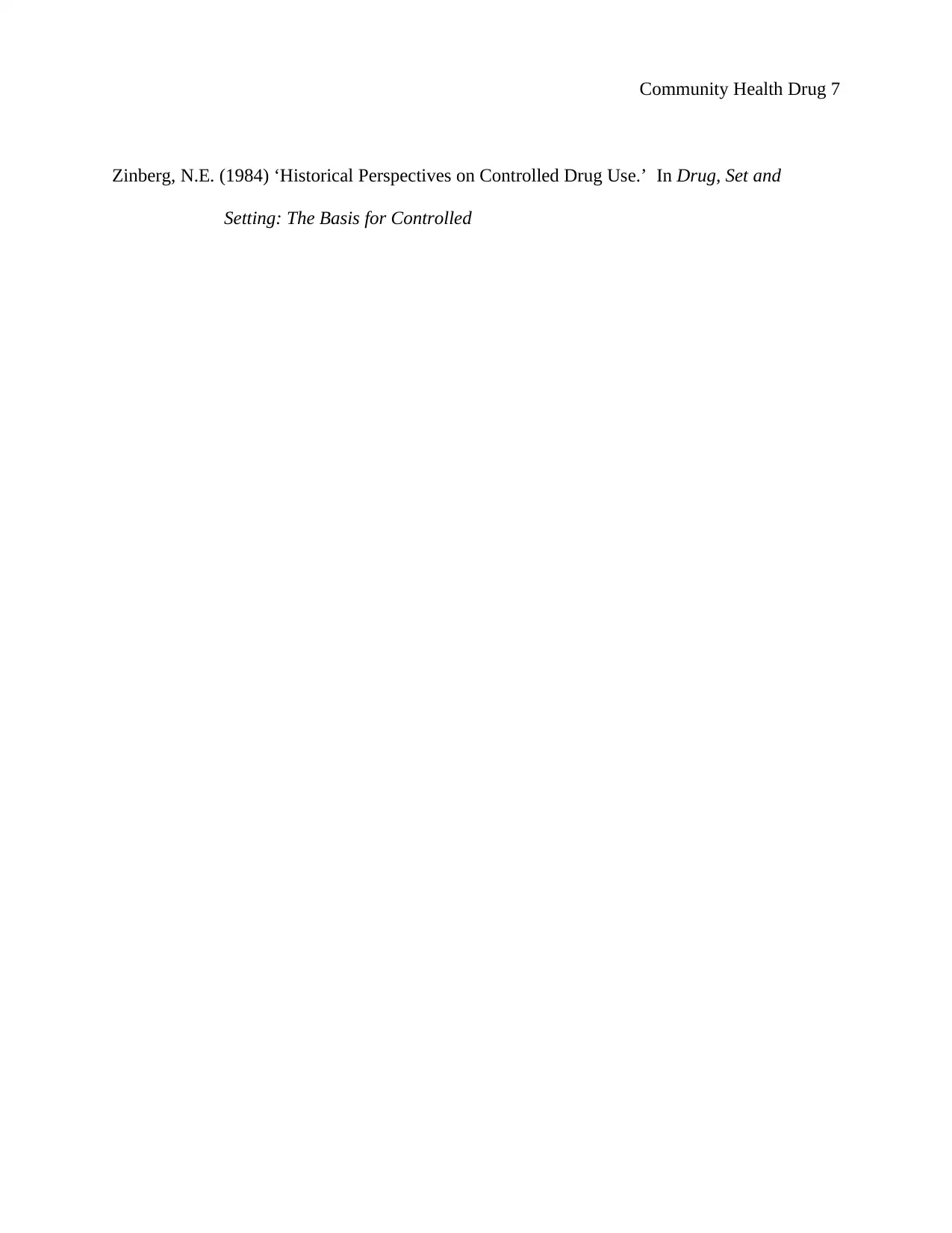Community Health Drug Essay: Social Processes and Drug Exchange
VerifiedAdded on 2022/11/28
|7
|1766
|1
Essay
AI Summary
This essay analyzes the social dynamics of drug exchange, drawing on a case study by Dwyer (2011) focusing on a heroin marketplace. The essay explores the issues raised by the case study, such as the challenges faced by researchers in establishing relationships and navigating the cultural nuances of the marketplace. It connects these issues to broader topics covered in class, including the consequences of drug usage and the influence of cultural perceptions and power dynamics. Furthermore, the essay delves into the complex social processes and relationships that surround the production and consumption of drugs, including the impact of drug prohibition, the role of social hierarchies, and the political implications of drug use. The analysis emphasizes the significance of social support in recovery and the role of socioeconomic conditions in drug exchange.

Community Health Drug 1
COMMUNITY HEALTH DRUG
By [name]
Course
Professor’s Name
Institution’s Name
Institution’s Location
Date
COMMUNITY HEALTH DRUG
By [name]
Course
Professor’s Name
Institution’s Name
Institution’s Location
Date
Paraphrase This Document
Need a fresh take? Get an instant paraphrase of this document with our AI Paraphraser

Community Health Drug 2
Introduction
The case study selected extensively discuses about the social life of smokers. Through the
essay, Dwyer pinpoints the role which social processes impact on the local market place in
Melbourne in regards to the exchange of drugs taking place. According to the author, drug
exchange areas, market places mainly are quantified systems of exchange, which can be
qualitatively evaluated and analyzed (Farrell 1998, pp.: 395-436). As such, most of the processes
are influenced by the customers and sellers attitude, cultural perceptions, development of social
relationships, and power distinctions according to the author. The analysis was done from a local
marketplace in Foot Cray found in Vietnam. This is where the heroine is at high levels. This
essays reviews issues which the case study stipulates and how they relate to the topic covered in
the weekly readings (Manderson 1995 pp.: 799-816). Lastly, it talks about the complex social
processes and relations which surround consumption and production of drugs.
What issues are raised by your case study?
As much as the researcher grew to become one of the most exceptional dealers, it took
time for him to establish the relationship. As such, there were numerous problems which they
encountered through the research (Lilienfeld et al., 2015). First, he used to market the drug in
one of the dangerous places. Heroin is one of the illegal drugs in the world, which can lead to
someone being detained. Secondly, the language used in the market place was different. No one
can trade with a person who is not familiar with a slang they use (Moore 1993). As such, there
are certain terms which are used by the drug dealers to ensure law enforcement officers do not
catch them. The researcher had to familiarize with this language first in order to work on his
research (Manderson 1995 pp.: 799-816).
Introduction
The case study selected extensively discuses about the social life of smokers. Through the
essay, Dwyer pinpoints the role which social processes impact on the local market place in
Melbourne in regards to the exchange of drugs taking place. According to the author, drug
exchange areas, market places mainly are quantified systems of exchange, which can be
qualitatively evaluated and analyzed (Farrell 1998, pp.: 395-436). As such, most of the processes
are influenced by the customers and sellers attitude, cultural perceptions, development of social
relationships, and power distinctions according to the author. The analysis was done from a local
marketplace in Foot Cray found in Vietnam. This is where the heroine is at high levels. This
essays reviews issues which the case study stipulates and how they relate to the topic covered in
the weekly readings (Manderson 1995 pp.: 799-816). Lastly, it talks about the complex social
processes and relations which surround consumption and production of drugs.
What issues are raised by your case study?
As much as the researcher grew to become one of the most exceptional dealers, it took
time for him to establish the relationship. As such, there were numerous problems which they
encountered through the research (Lilienfeld et al., 2015). First, he used to market the drug in
one of the dangerous places. Heroin is one of the illegal drugs in the world, which can lead to
someone being detained. Secondly, the language used in the market place was different. No one
can trade with a person who is not familiar with a slang they use (Moore 1993). As such, there
are certain terms which are used by the drug dealers to ensure law enforcement officers do not
catch them. The researcher had to familiarize with this language first in order to work on his
research (Manderson 1995 pp.: 799-816).

Community Health Drug 3
Thirdly, it was hard to get his customers who could help them with the research. As the
researcher had not traded in the market place before, he was not a familiar face before. They
were segregated as the Asians into one group (Lilienfeld et al., 2015). Such groups were rarely
unattended to. This brought about long hours of loneliness before they could get customers.
Relatively, it was hard building relationships through trust with the Vietnamese drug dealers
(Farrell 1998, pp.: 19). At times, some people were shy of the researcher. This could be because
he was not yet familiar with the people. Additionally, people had different thoughts about the
researcher’s intentions (Davenport-Hines, 2004). Thus, they were scared of trading with them.
Eventually, the researcher had to integrate with the lifestyle of the market place. For instance,
they had to smoke cigarettes to make the other dealers aware that they were not about to do some
shoddy business (Lilienfeld et al., 2015). Lastly, negotiation took lots of time for the first
customers. In any market place, new sellers are never trusted with what they offer. As such, the
people would take time trusting the researcher, which consumed a lot of time (Wodak, 2014).
Essentially, incorporating the ethnographer took time as it had much for preparation to take place
for the research to commence.
How do they relate to topics covered in class and weekly readings so far?
In a recently covered topic in class, the article relates to most of them. Most of the class
readings have been campaigning against drug usage. Additionally, they have bee sating some of
the consequences associated with the usage of certain drugs (Robson 1999). From the research
by Dwyer, there are conclusions which can be drawn. First, drug usage leads to social
relationships. For instance, market places emerged as a result of engaging in drug selling and
buying activities (Weil, 1973, pp.: 98-115). The relationships between sellers and buyers are
Thirdly, it was hard to get his customers who could help them with the research. As the
researcher had not traded in the market place before, he was not a familiar face before. They
were segregated as the Asians into one group (Lilienfeld et al., 2015). Such groups were rarely
unattended to. This brought about long hours of loneliness before they could get customers.
Relatively, it was hard building relationships through trust with the Vietnamese drug dealers
(Farrell 1998, pp.: 19). At times, some people were shy of the researcher. This could be because
he was not yet familiar with the people. Additionally, people had different thoughts about the
researcher’s intentions (Davenport-Hines, 2004). Thus, they were scared of trading with them.
Eventually, the researcher had to integrate with the lifestyle of the market place. For instance,
they had to smoke cigarettes to make the other dealers aware that they were not about to do some
shoddy business (Lilienfeld et al., 2015). Lastly, negotiation took lots of time for the first
customers. In any market place, new sellers are never trusted with what they offer. As such, the
people would take time trusting the researcher, which consumed a lot of time (Wodak, 2014).
Essentially, incorporating the ethnographer took time as it had much for preparation to take place
for the research to commence.
How do they relate to topics covered in class and weekly readings so far?
In a recently covered topic in class, the article relates to most of them. Most of the class
readings have been campaigning against drug usage. Additionally, they have bee sating some of
the consequences associated with the usage of certain drugs (Robson 1999). From the research
by Dwyer, there are conclusions which can be drawn. First, drug usage leads to social
relationships. For instance, market places emerged as a result of engaging in drug selling and
buying activities (Weil, 1973, pp.: 98-115). The relationships between sellers and buyers are
⊘ This is a preview!⊘
Do you want full access?
Subscribe today to unlock all pages.

Trusted by 1+ million students worldwide

Community Health Drug 4
dynamic and complex but form an interplay of social relationships. According to the class work,
it is possible to obtain information when there is a common agenda in social places (Cohen 2013,
pp.:177-192). In this case, using cigarettes as a means if exchange provided the leeway for the
researcher to obtain the information they wanted. According to the learning articles, there are
some notable lessons which can be acquired. For instance, drug prohibition is essential. In that
market place, it is clear that drugs have been prohibited despite the trade. This forms the basis of
why everyone is puzzled and shy to work with the researcher.
Also, there are key factors which influence the usage of drugs. Such include cultural
perceptions. In this case, one had to gift the seniors a cigarette. This was one of the cultures
which was adopted in the market place. Secondly, power differences also led to differences in
drug usage (Weil, 1973, pp.: 98-115). The high ranked would have more smoking zones
compared to other ordinary people. Lastly, power relationships between individuals was also a
factor in drug usage. Seniors were gifted more cigarettes as a way of appreciating their power
and as a cultural need. The exchange of drugs creates a social hierarchy and maintains it at the
same time.
What are the complex social processes and relations that surround the production and
consumption of drugs?
Beyond social processes, there lie political gains gained through the consumption and
distribution of drugs. For instance, it is linked to poor housing, influences the government
practices to the local black market (Zinberg, 1984). There is a significant growth in the local
black market as resources have been made available for drug dealers. As such, the daily lives of
citizens is highly affected. Also, usage of drugs has increased the political scenario which
dynamic and complex but form an interplay of social relationships. According to the class work,
it is possible to obtain information when there is a common agenda in social places (Cohen 2013,
pp.:177-192). In this case, using cigarettes as a means if exchange provided the leeway for the
researcher to obtain the information they wanted. According to the learning articles, there are
some notable lessons which can be acquired. For instance, drug prohibition is essential. In that
market place, it is clear that drugs have been prohibited despite the trade. This forms the basis of
why everyone is puzzled and shy to work with the researcher.
Also, there are key factors which influence the usage of drugs. Such include cultural
perceptions. In this case, one had to gift the seniors a cigarette. This was one of the cultures
which was adopted in the market place. Secondly, power differences also led to differences in
drug usage (Weil, 1973, pp.: 98-115). The high ranked would have more smoking zones
compared to other ordinary people. Lastly, power relationships between individuals was also a
factor in drug usage. Seniors were gifted more cigarettes as a way of appreciating their power
and as a cultural need. The exchange of drugs creates a social hierarchy and maintains it at the
same time.
What are the complex social processes and relations that surround the production and
consumption of drugs?
Beyond social processes, there lie political gains gained through the consumption and
distribution of drugs. For instance, it is linked to poor housing, influences the government
practices to the local black market (Zinberg, 1984). There is a significant growth in the local
black market as resources have been made available for drug dealers. As such, the daily lives of
citizens is highly affected. Also, usage of drugs has increased the political scenario which
Paraphrase This Document
Need a fresh take? Get an instant paraphrase of this document with our AI Paraphraser

Community Health Drug 5
surrounds it. There is an increased symbolism and attachment of the drugs. This is visible from
other sections of the world as attributed to other class readings. Drug usage increases the desire
for a person to achieve an altered consciousness making them escape the reality if their life.
In indigenous communities, usage and access to drugs are socially accepted. This arises
when there are permitted perceptions which escape or delving into conscious state and are
naturally celebrated (Weil, 1973, pp.: 98-115). Also, between individuals, drug exchanges are
considered socially acceptable products of social relationships.
Conclusion
The researcher had much ground to cover before they could develop their thesis about
this research. The entire process was time consuming. Time for him to establish the relationship.
They used to market the drug in one of the dangerous places, Secondly, the language used in the
market place was different. This meant they had to take time and learn about the language first.
Thirdly, it was hard to get his customers who could help them with the research. Lastly,
negotiation took lots of time for the first customers.
As such, it is sure to say that exchange and usage of drugs is affiliated to complex social
relationships. Also, it yields to cultural perceptions which coexist between human beings.
However, from the studies, it can be argued that social support can encourage people in their
path to quick recovery from drug usage and addiction. However, social relationships could be
much complex in criticism where cultural perceptions surround drug usage symbolism. Poor
socioeconomic conditions can greatly affect the exchange of drug usage and it usage.
surrounds it. There is an increased symbolism and attachment of the drugs. This is visible from
other sections of the world as attributed to other class readings. Drug usage increases the desire
for a person to achieve an altered consciousness making them escape the reality if their life.
In indigenous communities, usage and access to drugs are socially accepted. This arises
when there are permitted perceptions which escape or delving into conscious state and are
naturally celebrated (Weil, 1973, pp.: 98-115). Also, between individuals, drug exchanges are
considered socially acceptable products of social relationships.
Conclusion
The researcher had much ground to cover before they could develop their thesis about
this research. The entire process was time consuming. Time for him to establish the relationship.
They used to market the drug in one of the dangerous places, Secondly, the language used in the
market place was different. This meant they had to take time and learn about the language first.
Thirdly, it was hard to get his customers who could help them with the research. Lastly,
negotiation took lots of time for the first customers.
As such, it is sure to say that exchange and usage of drugs is affiliated to complex social
relationships. Also, it yields to cultural perceptions which coexist between human beings.
However, from the studies, it can be argued that social support can encourage people in their
path to quick recovery from drug usage and addiction. However, social relationships could be
much complex in criticism where cultural perceptions surround drug usage symbolism. Poor
socioeconomic conditions can greatly affect the exchange of drug usage and it usage.

Community Health Drug 6
References
Cohen, PT (2013) Symbolic dimensions of the anti-opium campaign in Laos, TAJA 24:177-192
Davenport-Hines, (2004). “Prologue,” The Pursuit of Oblivion.
Farrell, G (1998) ‘A Global Empirical View of Drug Crop Eradication and the United Nation’s
Substitution and Alternative Development Strategies,’ Journal of Drug Issues,
28(2): 395-436.
Lilienfeld, S., Lynn, S., Namy, L., Woolf, N., Jamieson, G., Slaughter, V., & Haslam, N.
(2015). Psychology: From Inquiry to Understanding. (2nd Ed.). Sydney: Pearson.
Manderson, (1995). 'Metamorphoses: Clashing Symbols in the Social Construction of
Drugs.’ Journal of Drug Issues 25(4): 799-816.
Farrell, Graham (1998), A global empirical review of drug crop eradication and United
Manderson, D. 2005. Possessed: Drug policy, witchcraft, and belief. Cultural
Studies 19(1)
Moore, (1993). “Beyond Zinberg’s ‘Social Setting.’”
Nations' crop substitution and alternative development strategies, Journal of drug issues 28(2)
(Nations' crop substitution and alternative development strategies)
Robson, (1999). Forbidden Drugs, second edition, chapter 2: “Consequences of Drug Use."
Weil, A (1973) ‘Clues from the Amazon.’ In The Nature of Mind, Jonathon Cape, London, pp.
98-115.
Wodak, A (2014). 'The abject failure of drug prohibition.' Australia and New Zealand Journal of
Criminology. Access at http://idhdp.com/media/362648/anj524424_rev2-
wodak.pdf.
References
Cohen, PT (2013) Symbolic dimensions of the anti-opium campaign in Laos, TAJA 24:177-192
Davenport-Hines, (2004). “Prologue,” The Pursuit of Oblivion.
Farrell, G (1998) ‘A Global Empirical View of Drug Crop Eradication and the United Nation’s
Substitution and Alternative Development Strategies,’ Journal of Drug Issues,
28(2): 395-436.
Lilienfeld, S., Lynn, S., Namy, L., Woolf, N., Jamieson, G., Slaughter, V., & Haslam, N.
(2015). Psychology: From Inquiry to Understanding. (2nd Ed.). Sydney: Pearson.
Manderson, (1995). 'Metamorphoses: Clashing Symbols in the Social Construction of
Drugs.’ Journal of Drug Issues 25(4): 799-816.
Farrell, Graham (1998), A global empirical review of drug crop eradication and United
Manderson, D. 2005. Possessed: Drug policy, witchcraft, and belief. Cultural
Studies 19(1)
Moore, (1993). “Beyond Zinberg’s ‘Social Setting.’”
Nations' crop substitution and alternative development strategies, Journal of drug issues 28(2)
(Nations' crop substitution and alternative development strategies)
Robson, (1999). Forbidden Drugs, second edition, chapter 2: “Consequences of Drug Use."
Weil, A (1973) ‘Clues from the Amazon.’ In The Nature of Mind, Jonathon Cape, London, pp.
98-115.
Wodak, A (2014). 'The abject failure of drug prohibition.' Australia and New Zealand Journal of
Criminology. Access at http://idhdp.com/media/362648/anj524424_rev2-
wodak.pdf.
⊘ This is a preview!⊘
Do you want full access?
Subscribe today to unlock all pages.

Trusted by 1+ million students worldwide

Community Health Drug 7
Zinberg, N.E. (1984) ‘Historical Perspectives on Controlled Drug Use.’ In Drug, Set and
Setting: The Basis for Controlled
Zinberg, N.E. (1984) ‘Historical Perspectives on Controlled Drug Use.’ In Drug, Set and
Setting: The Basis for Controlled
1 out of 7
Your All-in-One AI-Powered Toolkit for Academic Success.
+13062052269
info@desklib.com
Available 24*7 on WhatsApp / Email
![[object Object]](/_next/static/media/star-bottom.7253800d.svg)
Unlock your academic potential
Copyright © 2020–2025 A2Z Services. All Rights Reserved. Developed and managed by ZUCOL.